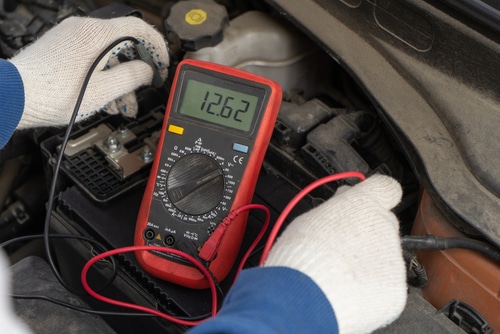Ever had your car throw a tantrum and flash the P0035 code at you? Don’t worry, you’re not alone in this automotive mystery.
This pesky code, also known as “Turbocharger Bypass Valve Control Circuit High,” is like that one friend who always shows up uninvited to your parties.

The P0035 code indicates that your vehicle’s Engine Control Module (ECM) has detected an unusually high voltage in the turbocharger bypass valve control circuit.
It’s basically your car’s way of saying, “Hey, something’s not quite right with my turbo system!”
This can lead to a host of issues, from decreased engine performance to that dreaded check engine light glowing on your dashboard.
You might notice your car feeling a bit sluggish, like it’s had one too many cheeseburgers. Or perhaps you’re experiencing a loss of power when you’re trying to show off at a stoplight.
Don’t fret, though. With a bit of detective work and some mechanical know-how, you can solve this turbo trouble and get your ride back to its former glory.
Key Takeaways
- P0035 signals a high voltage issue in the turbocharger bypass valve control circuit
- Symptoms may include reduced engine power and illuminated check engine light
- Proper diagnosis and repair can resolve the issue and restore vehicle performance
Understanding the P0035 Code
The P0035 code can be a bit of a head-scratcher, but don’t worry – we’ll break it down for you. This pesky little code is all about your turbocharger’s bypass valve and its control circuit.
Let’s dive into what it means and why it’s important for your engine’s performance.
What Is a P0035 Code?
P0035 is a diagnostic trouble code that pops up when your car’s computer detects a problem with the turbocharger bypass valve control circuit. Specifically, it means the circuit is registering as “high” when it shouldn’t be.
Think of it as your car’s way of saying, “Hey, something’s not quite right with the turbo!”
This code is part of the OBD-II system, which is like your car’s health monitor. When P0035 shows up, it’s time to put on your detective hat and figure out what’s going on under the hood.
Role of the Turbocharger Bypass Valve
Your turbocharger’s bypass valve is like a traffic cop for air in your engine. Its job is to control boost pressure by routing air where it needs to go.
When you’re cruising along, it might divert excess air away from the turbo to keep things running smoothly.
But when you need that extra oomph, it makes sure all that sweet, compressed air gets to your engine.
A faulty bypass valve can lead to all sorts of issues, from poor acceleration to that annoying check engine light glowing on your dashboard.
The control circuit for this valve is managed by your car’s computer. When the P0035 code pops up, it means there’s a communication breakdown between the computer and the valve.
It’s like they’re speaking different languages!
Common Symptoms of P0035

The P0035 code can manifest in several noticeable ways that might have you scratching your head. Let’s take a look at the telltale signs your turbocharged beauty might be suffering from this pesky problem.
Check Engine Light Illumination
You know that little light on your dashboard that looks like an engine? Well, it’s about to become your new nemesis.
When the P0035 code pops up, your Check Engine Light will likely illuminate faster than a Christmas tree.
This friendly reminder is your car’s way of saying, “Hey buddy, we need to talk!”
It’s not just being dramatic; it’s actually trying to save you from potentially costly repairs down the road. So when you see it, don’t just slap a piece of tape over it and call it a day. Your wallet will thank you later.
Changes in Engine Performance
Remember when your car used to zip around like it was auditioning for “Fast and Furious”? Well, with P0035, it might start performing more like a golf cart.
You’ll notice a significant drop in engine performance, almost as if your turbocharger decided to take an early retirement.
Your once peppy acceleration will feel sluggish, like your car is wading through molasses. You might also experience:
- Reduced power output
- Poor fuel economy (as if gas wasn’t expensive enough already)
- Rough idling, like your engine’s had one too many espressos
Sounds and Whistles Explained
Your car might start making noises that would put a steam locomotive to shame.
That signature turbo whistle you used to love? It might disappear entirely or sound more like a wheezy wheeze than a confident whoosh.
You might hear strange hissing sounds, especially when you’re accelerating.
This is your turbocharger’s way of saying, “Houston, we have a problem.”
These noises are often caused by boost pressure issues related to the malfunctioning bypass valve.
If your car starts sounding like it’s trying to communicate with dolphins, it’s probably time to pay your mechanic a visit. After all, cars aren’t supposed to whistle while they work!
Potential Causes of P0035

Got a P0035 code haunting your ride? Let’s dive into the gremlins that might be causing this turbocharger bypass valve hiccup. From pesky wires to problematic hardware, we’ll uncover what’s making your engine throw a fit.
Electrical Gremlins: Wiring and Connections
You know how finicky car electrics can be. Well, your P0035 might just be a case of wires gone wild.
Frayed, corroded, or loose connections can wreak havoc on your turbocharger’s control circuit.
Check those connectors, folks! A bit of wiggle here and there could be the culprit. Don’t forget to peek at the fuses and relays too. Sometimes, a blown fuse is all it takes to throw your turbocharged beast off its game.
Rodents love to chew on wires. If you’ve got a furry friend living under your hood, they might’ve had a wire feast. Time to break out the flashlight and play detective!
Faulty Hardware: From Valve to Supercharger
Now, let’s talk about the beefier bits.
Your turbocharger bypass valve might be stuck, worn out, or just plain lazy. When it doesn’t open or close as it should, your PCM throws a fit and lights up that pesky check engine light.
The actuator controlling the valve could be the troublemaker too. If it’s not responding to commands, you’ve got yourself a rebel on your hands.
Don’t rule out a faulty turbocharger or supercharger. These forced induction wizards can sometimes lose their magic, leading to all sorts of performance issues.
Lastly, keep an eye on those vacuum lines. A tiny leak can cause big problems. Give them a once-over for any cracks or disconnects. Your turbo will thank you!
The Diagnostic Procedure
Buckle up, folks! We’re about to dive into the nitty-gritty of diagnosing that pesky P0035 code.
You’ll need your trusty OBD-II scanner, a keen eye, and maybe a cup of coffee (or two).
Code Reading: First Steps
Alright, let’s kick things off with the basics.
Grab your OBD-II scanner and plug it in.
You’ll want to read not just the P0035 code, but any other codes that might be lurking. Sometimes these troublemakers travel in packs.
Next, clear the codes and take your ride for a spin. If P0035 pops up again faster than you can say “turbocharger,” you know you’ve got a persistent issue on your hands.
Don’t forget to check your freeze frame data. It’s like a snapshot of your engine’s vital signs when the code was set.
This info can be a goldmine for pinpointing when and why your turbocharger decided to throw a hissy fit.
Manual Inspections: What to Look For
Time to get your hands dirty!
First, give those wires leading to the bypass valve a good once-over. Look for any signs of wear, fraying, or damage. You’d be surprised how often a pesky rodent decides your engine wiring makes a tasty snack.
Next, check out the bypass valve itself. Is it stuck? Corroded? Looking sadder than a deflated balloon? These could all be culprits.
Don’t forget to inspect the vacuum lines if your bypass valve is vacuum-actuated. A tiny leak can cause big problems. Also, take a gander at your boost pressure sensor. It might be the silent troublemaker in this whole ordeal.
Pressure Tests: Boosting Your Diagnostics
Now for the fun part – pressure testing!
You’ll need a pressure gauge and a bit of patience. Hook it up to your intake manifold and fire up the engine. Your boost pressure should match what your trusty service manual says.
If your pressure’s lower than a limbo stick, you might have a leak in your intake or exhaust system. Higher than Mount Everest? Your wastegate might be throwing a tantrum.
Don’t forget to test the bypass valve itself. Apply vacuum (if it’s vacuum-operated) or voltage (if it’s electrically controlled) and watch for proper operation.
If it’s not moving smoother than a well-oiled robot, you’ve found your culprit.
Home Fixes Versus Professional Help
You’re probably wondering if you can fix this pesky P0035 code yourself. Well, good news! Some solutions are definitely DIY-friendly.
Start by checking those vacuum lines – they’re often the culprits behind this code.
Look for any that are collapsed, disconnected, or split. If you find a damaged line, replacing it might just solve your problem.
But let’s be honest – not everyone’s a grease monkey. If you’re more comfortable with a TV remote than a wrench, it might be time to call in the pros.
A reputable auto shop can diagnose and fix the issue, typically costing between $75 to $150 for diagnostics alone.
Remember, messing with your turbocharger isn’t like changing a tire. If you’re not confident, it’s better to leave it to the experts.
The Replacement Ritual
Sometimes, a simple fix won’t cut it. You might need to replace the turbocharger bypass valve or its control solenoid. This is where things get a bit trickier.
First, locate the valve – it’s usually near the turbocharger.
Disconnect the battery (safety first, folks!) and remove any components blocking access.
Carefully disconnect the electrical connectors and vacuum lines.
Now, here’s the fun part – out with the old, in with the new!
Make sure your replacement part matches the original. Reconnect everything, double-checking those connections. It’s like a high-stakes game of Operation, but with car parts.
Final Checks: Ensuring a Clean Bill of Health
You’ve done the hard part, but you’re not out of the woods yet. Time for some final checks to ensure your P0035 troubles are truly behind you.
First, clear that pesky code from your car’s computer. You’ll need an OBD-II scanner for this – borrow one if you don’t have it. It’s like giving your car a clean slate.
Next, take your ride for a spin.
Listen for any unusual noises and keep an eye on your dashboard. If that check engine light stays off, you might just be in the clear.
Still having issues? It might be time to check for electrical problems.
A faulty wiring harness or corroded connections can mimic a bad bypass valve. Don’t be afraid to get a second opinion if things aren’t adding up.
Frequently Asked Questions
Troubleshooting turbocharger bypass valve control issues can be tricky, but we’ve got you covered. Let’s dive into some common questions about the P0035 code across different vehicle makes and models.
How do I troubleshoot a turbocharger bypass valve control issue on my Nissan?
First, check your Nissan’s electrical connections for any signs of damage or corrosion. You’d be surprised how often a loose wire is the culprit!
Next, inspect the bypass valve itself. If it’s stuck or clogged, you might need to give it a good cleaning or replace it altogether.
Could you give me guidance on fixing a P0035 fault code for a Ford vehicle?
For your Ford, start by scanning for other related codes. Sometimes, P0035 brings friends to the party.
Check the boost pressure sensor, as it’s often the troublemaker in these situations. If it’s faulty, replacing it might just solve your problem.
What steps should I take to correct a P0035 error on a Chevy Silverado?
Your Silverado’s vacuum lines could be the source of the issue. Take a look for any that are collapsed, disconnected, or split.
Don’t forget to inspect the wiring harness connected to the bypass valve. Rodents love to make meals out of these wires!
What should I look for when my Chevy Cruze has a P0035 code indication?
In your Cruze, pay special attention to the turbocharger bypass valve itself. These can fail over time, leading to that pesky P0035 code.
Also, check the PCM (Powertrain Control Module). Sometimes, a software update can resolve the issue without any parts replacement.
Can you tell me how to repair a P0035 code in a Chevy Malibu without breaking the bank?
Start with the basics: clean the mass airflow sensor and check for any vacuum leaks. These are inexpensive fixes that could save you a bundle.
If that doesn’t work, consider testing the bypass valve yourself before replacing it. A multimeter can be your wallet’s best friend here.
What are common reasons for a P0033 code to appear, and are they similar to the P0035 in my Toyota?
While P0033 and P0035 are cousins, they’re not identical twins.
P0033 typically indicates a low circuit issue, while P0035 points to a high circuit problem.
For your Toyota, check the wiring between the PCM and the turbocharger bypass valve. A short to power could be causing that P0035 to pop up.
